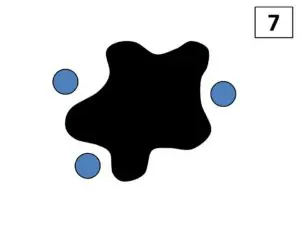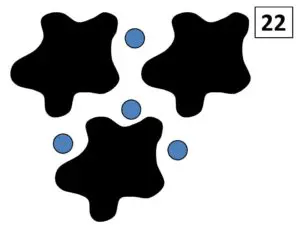How to Number Talk: Splat!

Naomi Dupre-Edelman MATM’21, assistant director of math leadership programs at Mount Holyoke College, shares a fun way for students to practice their reasoning skills with a game called Splat!
How To Number Talk: Splat!
Splat!, created by Steve Wyborney, is a creative way to get students to visualize and quickly solve for an unknown without realizing they’re doing it. Splat! uses a reveal to create an engaging routine that asks students to solve how many dots are under the Splat.
This activity can help improve students’:
- Fluency of basic math facts.
- Reasoning skills.
- Flexibility with numbers.
- Ability to decompose numbers and put them back together.
Splat! is something you can easily make yourself, but through Wyborney’s blog, you can find over 50 Splat! routines pre-created as PowerPoint slides and ready to use in your classroom.
How To Do It
Show the picture of the Splat. Ask students to share what they notice and wonder about it. You want to draw their attention to a few things:
- The Splat(s)
- The visible dots
Give them the number of total dots (visible and covered) and ask them, “How many dots are under the Splat?” There are several ways to engage students in thinking about this depending on whether you’re utilizing one or multiple Splats. There’s a lot of onomatopoeia in here and not a lot of visuals, so grab a pencil and let’s try one together!

How many blue dots do you see? How many dots are under the Splat?

Let’s try a more challenging one. When there are multiple Splats of the same color, there must be the same number of dots under the Splats.
Before you begin, quickly note how many blue dots and how many Splats you see.
How many dots are under the Splats?
How many dots are under each Splat?
There are multiple other versions, including multicolored Splats and fraction Splats that have students dive into thinking about variables and multiplication/division.
Questions To Ask:
- What do you notice? What do you wonder?
- How many dots do you see? How many dots are hiding?
- What is a number sentence or equation we can write to record this Splat?
- Is there another way to see these Splats?
- How did you see them?
Links to Standards of Mathematical Practice
Number talks are great opportunities to link back to those Standards of Mathematical Practice (SMPs). Here are the top two SMPs we believe a Splat! challenge highlights:
- SMP 2: Reason abstractly and quantitatively
Students have the opportunity to share how they solved the Splat individually and explain their strategies using the context of the picture and their understanding of numbers. They must express their reasoning both quantitatively (through the numbers) and by attaching their understanding of operations to those numbers. - SMP 3: Construct viable arguments and critique the reasoning of others
Students participating in these exercises must be able to support their answers with sound arguments ofhow they know based on their number sense skills. This also means that other students need to find ways to share whether they believe another student’s reasoning is inaccurate or correct and support their argument with evidence.
Where To Find Them:
- Steve Wyborney Blog: Splat!: there’s a great informational video about a quarter way down the page.
- Make your own! Make it a math “project” or invite the art teacher in and create a Splat! bulletin board.
Sign up for twice-monthly math resources and hear about other professional development opportunities from Math for Teachers by Mount Holyoke College.